

Superspreaders Drove Ebola Epidemic, Study Finds. The story is well known among Ebola experts - the traditional healer who died from the virus in Sierra Leone and whose body infected 13 mourners at her funeral, who in turn infected more than 300 other people.

It's called a "superspreading" event, and a new analysis shows that just 3 percent of patients caused more than 60 percent of all infections in other people during the West African Ebola epidemic. It's another piece of evidence showing that certain people are key to spreading disease. If doctors and public health officials can learn more about why and how, perhaps they can learn how to nip epidemics in the bud.
Ebola Virus - News, Pictures, Videos & Facts on the deadly outbreak. Ebola. Ebola: The secret hideout of the virus. There was a certain kind of quiet hopefulness when, in late April this year, the last Ebola patient of the West African epidemic – a two-year-old boy – walked out of a treatment facility in Monrovia, Liberia.

With the smouldering embers of the outbreak fading, there was cause for celebration. But there remains the impotent fear of the unseen: Ebola is still out there, lurking. We just don’t know where it’s hiding or when it will be back. If we’re going to stop Ebola in the future, we have to find its hiding places. Ebola is a zoonotic disease, meaning that it can spread between animals and humans.
Its ruthless nature means that we are often the end of the line for the virus: a host like us that gets too sick too fast, that dies too quickly, cuts down the virus’s ability to jump into a fresh body. Ebola Outbreak. Volunteers of the Liberia Red Cross Society have been working tirelessly since the beginning of the outbreak.
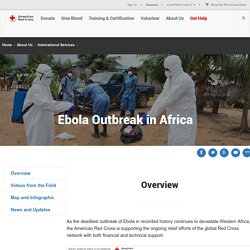
Red Cross teams are working to break the chain of transmission in Guinea, Liberia and Sierra Leone, the three countries with sustained and widespread transmission of the virus. The bodies of Ebola victims are highly infectious, and funeral preparations and ceremonies have been a significant source of infection. Specially trained Red Cross volunteer teams working in affected communities have safely buried more than 1,300 bodies. Volunteer teams have traced and monitored nearly 20,000 people who have been in contact with an Ebola patient, monitoring them for three weeks to ensure any resulting cases are quickly identified, isolated and treated.
Red Cross volunteer teams have also disinfected more than 16,000 homes to kill the virus and prevent infection in places where Ebola patients have lived or visited. Ebola Virus Infection: Practice Essentials, Background, Pathophysiology and Etiology. Ultrastructure and pathogenesis The known members of the family Filoviridae are the genera Ebolavirus (Ebola virus) and Marburgvirus (Marburg virus).
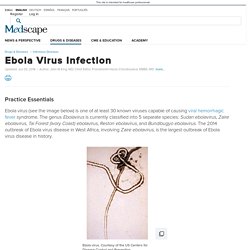
According the 2012 virus taxonomy of the International Committee on Taxonomy of Viruses, Ebolavirus is classified into the following 5 separate species: Sudan ebolavirus Zaire ebolavirus Tai Forest ebolavirus (formerly and perhaps still more commonly Ivory Coast ebolavirus or Côte d’Ivoire ebolavirus) Reston ebolavirus Bundibugyo ebolavirus Filoviruses such as Ebola virus share a characteristic filamentous form, with a uniform diameter of approximately 80 nm but a highly variable length. Filaments may be straight, but they are often folded on themselves (see the image below). No, Seriously, How Contagious Is Ebola? Update on Oct. 8: The Ebola patient in Dallas, the first diagnosed with the virus in the U.S., has died.
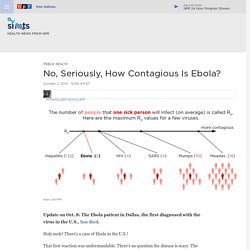
Holy moly! There's a case of Ebola in the U.S.! That first reaction was understandable. There's no question the disease is scary. The World Health Organization now estimates that the virus has killed about 70 percent of people infected in West Africa. How Ebola sped out of control. On July 30, she implored Chan to declare an international health emergency.
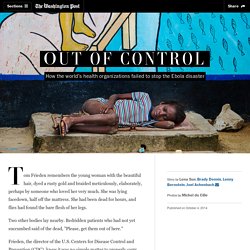
Chan responded that she was being very pessimistic, Liu said. Liu replied: "Dr. Chan, I'm not being pessimistic. I'm being realistic. " Chan soon flew to West Africa to meet with the presidents of Guinea, Liberia and Sierra Leone, and announced a $100 million push to stop the outbreak. On Aug. 8, the WHO declared a global health emergency. Chan declined to comment for this article. But after six trips to Africa during the epidemic, he has seen a more profound truth: Global organizations can provide epidemiologists and laboratory help, but what these resource-poor countries really need are front-line doctors and nurses, and basic resources. He visited a clinic where 25 health-care workers became sick with Ebola and 23 died.
Ebola Virus: Symptoms, Treatment, and Prevention. Ebola is a rare but deadly virus that causes bleeding inside and outside the body.
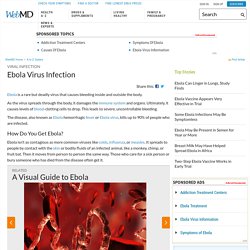
As the virus spreads through the body, it damages the immune system and organs. Ultimately, it causes levels of blood-clotting cells to drop. This leads to severe, uncontrollable bleeding. The disease, also known as Ebola hemorrhagic fever or Ebola virus, kills up to 90% of people who are infected. How Do You Get Ebola? Ebola: Symptoms, Causes and Treatments.
The 2014 Ebola outbreak is the largest in history, primarily affecting Guinea, northern Liberia, and Sierra Leone.

The Centers for Disease Control and Prevention (CDC) estimates that the epidemic has caused more than 11,000 deaths, with almost all those deaths occurring in countries in West Africa. In the US, reports indicate that there have been two imported cases, including one death, and two locally acquired cases in healthcare workers. A small number of cases were reported in Nigeria, Mali and Senegal, with health authorities able to contain these cases and prevent further spread. Medical News Today examines the effects of Ebola on the human body and the current concerns people may have about the virus.
Ebola virus disease (EVD), previous known as Ebola hemorrhagic fever (Ebola HF), is a serious, often fatal condition in humans and nonhuman primates such as monkeys, gorillas and chimpanzees. Disease Directory. What You Need to Know About the Ebola Outbreak. Ebola Fast Facts. Facts:Ebola hemorrhagic fever is a disease caused by one of five different Ebola viruses.

Four of the strains can cause severe illness in humans and animals. The fifth, Reston virus, has caused illness in some animals, but not in humans. Ebola is extremely infectious but not extremely contagious. It is infectious, because an infinitesimally small amount can cause illness. Laboratory experiments on nonhuman primates suggest that even a single virus may be enough to trigger a fatal infection.
Ebola: MedlinePlus. Ebola hemorrhagic fever is caused by a virus.

It is a severe and often fatal disease. It can affect humans and other primates. The Ebola Outbreak in West Africa. Ebola virus disease.